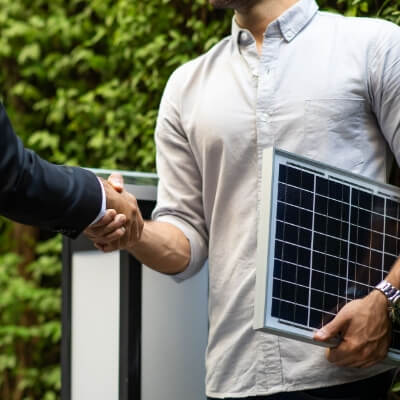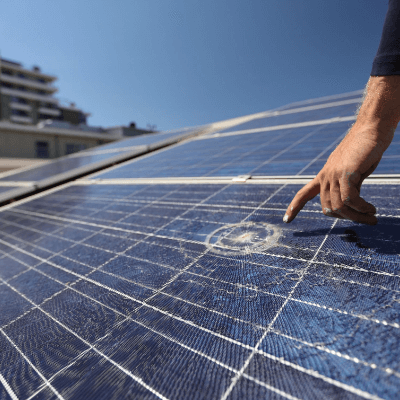Solar power systems: the risks and how to manage them
- At last count there were over 3 million solar systems in Australia, and with increasing energy costs that figure is only likely to rise
- Solar panels have wide-ranging benefits, but also create risks for businesses that need to be managed
- These risks include fire and hail damage - ensuring the correct insurance levels can help protect businesses if something goes wrong.
Solar panels are an increasingly common sight on rooftops across the nation. In fact, according to the latest figures, there are 3.04 million solar system installations in Australia1.
And it’s no surprise. With climbing energy prices and many of us firmly focusing on green energy, solar energy systems offer significant benefits to property owners.
However, as with any complex energy system, they bring unique risks and insurance considerations, advises Bob Algie, National Product Specialist – Property, and Chris Deugarde, Risk Engineer at QBE.
How solar systems work
Photovoltaic (PV) solar installations are the most common type of solar installation used in commercial and residential properties.
PV installations use a process that converts sunlight directly into electricity by using a semiconductor PV cell.
PV cells are usually joined together to form what we know as a solar panel. A grid-connected solar PV system will feed energy to an inverter, which will then feed the electricity to the main electricity grid of the property.
Installation risk
PV solar systems must be correctly installed and maintained to ensure safety and efficiency - this includes the mounting system and cabling, says Algie.
“A mounting system attaches the solar system to the ground, or most commonly, the roof of a property.
 “It’s important that the racking is resistant to corrosion and appropriate for the roof if it’s installed on one.”
“It’s important that the racking is resistant to corrosion and appropriate for the roof if it’s installed on one.”
“This is particularly important for older buildings, where the roof hasn’t been constructed to take the weight of panels - and where engineering reports, with a load analysis, should be undertaken,” adds Deugarde.
“We also recommend customers have a professional roofing inspection to ensure the roof is structurally sound before installation, and as part of regular maintenance.”
Another component that risk engineers will assess is the electrical cabling, he adds. This cabling should have insulation appropriate to the conditions it’s exposed to.
Algie and Deugarde recommend using Clean Energy Council (CEC) Approved Solar Retailers for confidence around the installation and system.
These retailers provide a five-year system warranty and will ensure a CEC accredited installer sets the system up, says Deugarde.
“Using an approved retailer is also generally a requirement to secure government rebates.”
Weather-related risk
Claims relating to storm events, and hail as a subset of these events, are among the most common and costly in the property insurance space. So it’s unsurprising hail is the leading driver behind solar system damage and claims, says Deugarde.
 “Occasionally, strong winds can damage panels or mounting hardware, and in cold climates, frost can cause cracks in solar cells - but events where hail stones exceed the size panels can withstand are the biggest claims driver.”
“Occasionally, strong winds can damage panels or mounting hardware, and in cold climates, frost can cause cracks in solar cells - but events where hail stones exceed the size panels can withstand are the biggest claims driver.”
Australian standards stipulate a panel needs to withstand the force of hail 35mm in diameter, but in some instances, Australia has seen hailstones larger than this.
“A recent hailstorm in Queensland saw hailstones up to 160mm in diameter, says Deugarde.
Subsequently, properties in areas prone to severe storms and large hail stones are most at risk.
“Unfortunately, there’s not much we can do to minimise this risk if there’s a significant storm, so ensuring appropriate insurance cover and sums insured are in place in case of a major hail event is key.”
Fire risk
Although not as common as weather-related incidents, another risk for property owners to consider is fire.
Solar panels introduce an additional source of electricity, another ignition source and new combustible materials to a property.
The potential impact of a fire in terms of damage can be major, says Deugarde.
If wiring or an inverter has a fault or fails, arcing can occur (where the electrical current will pass through the air due to a loose or high resistance connection). This can cause extreme temperatures and, in the worst-case scenario, fire.
Panels, cabling and other components can release toxic fumes when on fire and create additional challenges for firefighters.
They can also encourage a fire to spread more rapidly across a roof by tracking underneath the panels.
Ensuring inverters are installed and maintained, and have safeguards in place, can lower fire risk significantly, adds Algie.
These safeguards can include electrical protection measures like arc fault detection devices. They can also include physical and impact protection mechanisms like barriers, steel cages, bollards, and other measures to defend from direct sunlight, rain, and water spray.
“Ideally, inverters should be installed internally on a structurally sound and non-combustible wall in a dry area, capable of bearing the extra weight of the inverter.
For example, this means avoiding installation on walls constructed from insulated sandwich panels with flammable cores (e.g., polystyrene).
“The inverter should also be installed off the ground and away from combustibles.”
“It’s also important to check if isolation switches are installed and whether there’s surge protection.
Another consideration is access, “given water spray from fire hoses and hydrants can only reach four storeys, the height of the panels is a risk factor we consider,” says Algie.
“Where surge protection isn’t installed or access is inhibited, a customer may face higher policy deductibles.”
Avoiding underinsurance
Ensuring businesses have the right insurance cover is key, says Algie.
Sums insured should be reviewed regularly and incorporate the current costs of solar system replacement.
 While it’s fair to say the cost of solar technology itself has reduced as uptake has increased, rising labour costs are a significant contributing factor in total replacement costs. Global supply shortages can also mean replacing panels with like-for-like may also be challenging.
While it’s fair to say the cost of solar technology itself has reduced as uptake has increased, rising labour costs are a significant contributing factor in total replacement costs. Global supply shortages can also mean replacing panels with like-for-like may also be challenging.
“If a customer paid $30,000 five years ago for a solar system and a hailstorm means it has to be replaced, $30,000 may not be enough to replace an equivalent system today.”
Additionally, some council regulations require property rebuilds or repairs to include minimum solar power inclusions, so this should also be a factor when determining sums insureds.
Property or solar system damage can compromise business operations, so business interruption insurance should also be a consideration, says Algie.
It not only covers full-scale shutdowns after an insured event – but can also cover costs customers may not expect.
“For example, if a factory’s panels are out of action because of an insurable event, the business can claim the additional power costs under business interruption cover.”
Talk about solar today
Thanks to its environmental and energy cost-saving benefits, solar power is destined to become an increasingly important component of our national energy production. By ensuring risks are managed and business operations and assets are covered with the right insurance, businesses can move into a brighter solar-powered future.
Visit QBE Risk Solutions for more risk insights and resources.
1 https://www.energycouncil.com.au/media/5wkkaxts/australian-energy-council-solar-report_-jan-2022.pdf

